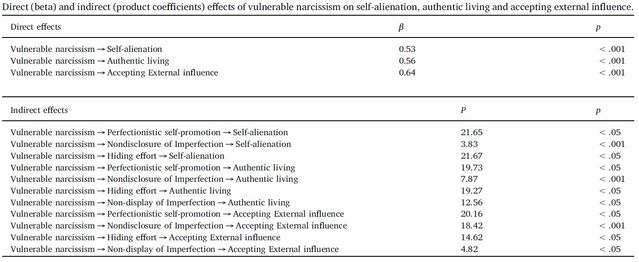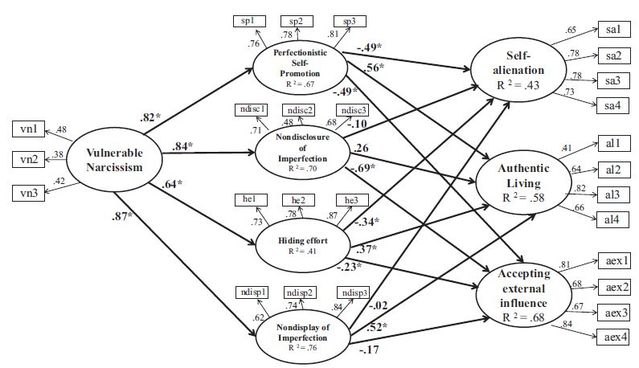Narcissism
Sacrificing Authenticity on the Altar of Narcissism
Compelling research on image management, authenticity, and perfection.
Posted August 20, 2018 Reviewed by Davia Sills
"Authenticity means erasing the gap between what you firmly believe inside and what you reveal to the outside world." —Adam Grant
The importance of being authentic
Would you rather be authentic and slightly tarnished, or shiny and maybe a tad plastic? There are folks who live and die by authenticity; it is the highest virtue for them. Authenticity is associated with capital-T truth.
In its idealized form, the implicit assumption is that authenticity is the path to happiness, though some find authenticity the path to ruin. But authentic ruin remains authentic. Falseness leads to a different kind of folly, as the ending draws nearer. In cultures that exalt inauthenticity, self-destruction becomes a virtue, and people become disposable. False authenticity is one of the best places to hide inauthenticity.
Authenticity has its virtues, in spite of the hype. Authenticity is important to well-being, often connecting directly with whether we feel good or bad about ourselves. When is authenticity useful? When is authenticity adaptive, even?
In cultures that extol authenticity, it is rewarded socially. A social reward is a key component to success. Authentic people are well-liked and often sought-after. Consider the trend in product marketing and executive presentations in which being real is vulnerable, persuasive. Such branding may appeal to the kernel of authenticity many crave. Can authenticity be bought and sold on the open market? How can we distinguish between the appearance of authenticity and actual authenticity?
Real healthy
Wood and colleagues (2008) developed a useful, three-component model of authenticity. According to their analysis, the three statistically distinct elements are 1) self-alienation, 2) accepting external influence, and 3) authentic living. These factors, in turn, correlate with estimates of subjective well-being and psychological well-being.
When we feel significant self-alienation and are too accepting of external influence, we won't feel very good about ourselves. It nags at us, won't go away, an itch we can't scratch. People who aren't living authentically may suffer from the sense that something is missing, with a degree of confusion around the finer points.

How about narcissism? Are narcissistic people more "real" than others? Narcissists may not only feel a need to feel perfect, but they may also try to present themselves as falsely flawless in order to project an image of perfection. Some of us see right through that, while others find it strangely seductive and charismatic.
Is it inauthentic to present a cultivated image, or is it authentic to meet emotional needs for esteem or safety? Is being flawlessly false an achievement of perfection? First, we have to understand a bit about how perfectionism can be conceptualized.
There are three contributors to perfectionism: self-oriented perfectionism (wanting oneself to be perfect), other-oriented perfectionism (wanting others to be perfect), and socially prescribed perfectionism (believing that others want us to be perfect). Perfectionist image management in narcissism is thought to be an interpersonal strategy to enhance self-esteem—whether doing so is for the primary reward of admiration, to cover up insecurities, or both. There are four ways people can try to project and perform perfection: 1) perfectionistic self-promotion, 2) nondisclosure of perfection, 3) hiding effort, and 4) non-display of perfection.
Trying to appear perfect is hard work, and some are more skillful than others at it—a few are naturals. Notably, authenticity itself must be an important part of appearing perfect because the performance has to seem real. If narcissistic people have an issue with inauthenticity, it may create problems believing in one's own perfection, let alone making others believe as well. We may never stop faking it, even if we believe we have made it.
Relating narcissism, authenticity, and perfectionism
How do the elements of narcissistic type and perfectionistic image management relate to authenticity? Researchers Casale, Rugai, Fioravanti, and Puccetti (2018) at the University of Florence wanted to see whether people with stronger narcissism of grandiose and vulnerable types experience authenticity differently, and if so, in what ways. Working with 274 White university student research volunteers, equally women and men, they administered a series of tests, surveys, and other measures looking at key areas of relevance to the study.
Participants completed measures of grandiose and vulnerable narcissism, using the Narcissistic Personality Inventory and Hypersensitive Narcissism Scales, respectively. (It is worth noting that narcissism may not be either/or; grandiosity and vulnerably can coexist to varying degrees in different individuals (Fossati et al., 2015).)
Participants also completed the Perfectionistic Self-Presentation Scale, with items regarding perfectionistic self-promotion (e.g., “I try always to present a picture of perfection”), with the nondisclosure of imperfection (e.g., “Admitting failure to others is the worst possible thing”), and non-display of imperfection. Hiding effort was estimated using the aptly-named Perfectionistic Self-Presentation Hiding Effort Scale.
Participants completed the Authenticity Scale, gauging the independent factors of self-alienation, acceptance of external influence, and authentic living discussed earlier. What are the relationships, if any, between the type of narcissism, the four strategies for managing image perfectionism, and the three dimensions of authenticity?
Perfection, grandiosity, vulnerability, authenticity
The first major observation is that there was no statistically significant relationship between grandiose narcissism and authenticity, except for a slight correlation with not believing one has to conform to others’ expectations. Grandiose narcissism was squarely associated with self-promotion.
How do efforts to create an aura of perfection around oneself relate vulnerable narcissism and authenticity? Unlike grandiose narcissism, for vulnerable narcissism, there were direct and indirect effects on authenticity via the possible image management strategies. For authenticity and vulnerable narcissism, accepting external influence accounted for 68 percent of the variance, authentic living accounted for 58 percent, and self-alienation 43 percent. Authenticity was negatively affected by vulnerable narcissism, with different perfectionistic presentation strategies detracting from different aspects of authenticity.
The relationship between vulnerable narcissism and self-alienation was mediated indirectly thought perfectionistic self-promotion, nondisclosure of imperfection, and hiding effort. Authentic living was mediated by perfectionistic self-promotion, nondisclosure of imperfection, hiding effort, and non-display of emotion. Accepting external factors was mediated by all four factors as well. These results are summarized here:

What does it mean? Grandiose narcissism may come more from authentic experiences of oneself in relation to others, while vulnerable narcissism has roots in a coping or defensive style. Grandiose narcissism may represent more of a “true self” rather than vulnerable narcissism, which is taken to be a kind of false self-image.
Self-promotion is a common feature of both forms of narcissism, but vulnerable narcissism attempts to manipulate self-presentation out of insecurities and fears. The study authors conclude that inauthenticity is a core feature of vulnerable narcissism, noting, "The current findings support the hypothesis that efforts to be seen as perfect lead vulnerable narcissists to take some distance from their true selves. Basically, the search for admiration among vulnerable narcissists often involves hiding aspects of the self..."
Significance
This study has significant implications. For anyone interacting professionally with folks with problematic narcissism, whether a therapist seeking to help, or managers and co-workers looking to collaborate productively, or family and friends trying to make things work, understanding image management strategies and the impact on self-satisfaction, or lack thereof, is valuable intel. For someone dealing with their own narcissism, this research is an important road map for self-exploration, providing important clues about where things break down.
Traumatic narcissism?
Vulnerable narcissism is closely tied with neuroticism, and to a lesser extent, agreeableness (Miller et al., 2018). Vulnerable narcissism has been associated with childhood trauma history (Bachar, 2015), and the concept of “traumatic narcissism” has been used to frame deeply problematic interactions between "traumatizing narcissists" and "traumatized narcissists" (Shaw, 2013), where the failure of recognition undermines basic humanity. Among other things, the sense of empathy surrounding grandiose and vulnerable narcissists is quite different and leads to different ways of relating.
The implications for authenticity are also curious and relate not just to pathological narcissism, but also healthy narcissism—having a sturdy and positive sense of self, a balanced need for recognition, and so on. For some, authenticity and recovery (e.g., from traumatic narcissism) may be intertwined, whereas, for others, inauthenticity is not a problem. In the long run, we'd expect vulnerable narcissism to be less stable, as feelings of inauthenticity gradually undermine a shaky sense of self.
Grandiose narcissists, on the other hand, are not necessarily interested in changing, and by and large, may be essentially living true to themselves—even if it doesn’t always work for others. Vulnerable narcissists are more likely to be living falsely. They could, in principle, benefit from greater authenticity if the cost of going there is worth it. As individuals, we are left to consider our own characteristics.
Please send questions, topics, or themes you'd like me to possibly address in future blogs via my PT bio page.
Statistical model for vulnerable narcissism

References
Bachar, E., Canetti, L., Hadar, H. et al. Child Psychiatry Hum Dev (2015) 46: 800. https://doi.org/10.1007/s10578-014-0521-z
Casale S, Rugai L, Fioravanti G & Puccetti C. Narcissism and authentic self: An unfeasible marriage? Personality and Individual Differences 135 (2018) 131–136.
Fossati A, Feeney J, Borroni S, Maffei C. The structure of pathological narcissism and its relationships with adult attachment styles: A Study of Italian Nonclinical and Clinical Adult Participants Psychoanalytic Psychology, 2014 American Psychological Association 2015, Vol. 32, No. 3, 403– 431.
Miller JD, Lynam DR, Vize C, Crowe M, Sleep C, Maples‐Keller JL, Few LR & Campbell KW. Vulnerable Narcissism Is (Mostly) a Disorder of Neuroticism. J Pers. 2018 Apr;86(2):186-199.
Shaw D. Traumatic Narcissism: Relational Systems of Subjugation, Relational Perspectives Book Series (Book 58). Routledge; 1 edition (September 18, 2013)




